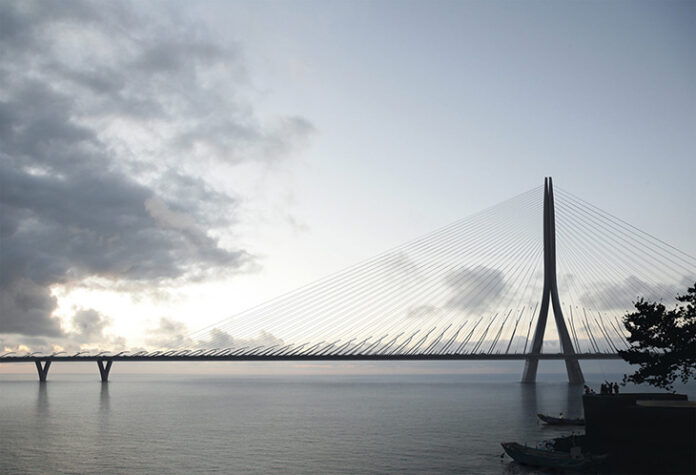
In 2025, Taiwan will be home to one of the most breathtaking and ambitious feats of engineering the world has ever seen. The Danjiang Bridge, designed by the late architectural icon Zaha Hadid, is poised to make history as the longest single-span, single-mast, cable-stayed bridge ever built. This groundbreaking structure isn’t just a bridge—it’s a symbol of visionary genius that will forever bear Hadid’s indelible mark on the world.
The legendary Iraqi-British architect, often hailed as “The Queen of the Curve,” passed away in 2016, just a year after finalizing the plans for this monumental project. The Danjiang Bridge will stand as one of her last masterworks, a testament to her extraordinary ability to blend form, function, and innovation. It’s more than just a means of transportation—it is a statement of the future.

Spanning a massive 3,000 feet across the Tamsui River, the Danjiang Bridge will reduce traffic congestion on a nearby bridge, while also providing a critical connection for pedestrians, cyclists, and vehicles. It will even feature space for a light rail network, making it a key element in enhancing Taiwan’s northern coastal traffic network.
Yet it’s not just about getting from point A to point B. The design of the bridge, which will rise an impressive 200 meters (roughly 620 feet) above the river, is a marvel of architectural thoughtfulness. In keeping with Hadid’s reputation for pushing the boundaries of design, the bridge will be supported by a single, sleek concrete mast. This unique asymmetrical cable-stayed structure ensures minimal visual impact on the surrounding environment, while also mitigating any potential disruption to the sensitive estuary ecosystem and boating traffic below. As Hadid’s architectural firm points out, “The mast’s placement has been chosen to avoid interfering with the views of the sunset, creating a delicate balance between technology and nature.”
The aesthetics of the bridge are as much a part of its design as its functionality. Hadid’s vision was always to create a structure that wasn’t just practical, but an awe-inspiring work of art. The slender concrete mast will rise from the earth like a piece of sculpture, while the elegant cables will stretch across the span, creating a seamless, dynamic curve that reflects Hadid’s signature style. This will be one of the most visually striking pieces of infrastructure ever to grace the skyline of Taiwan—and the world.
But the beauty of the Danjiang Bridge goes far beyond its curves and cables. Its construction will significantly ease the flow of traffic in northern Taiwan, particularly around the Port of Taipei and Taoyuan International Airport, key economic hubs for the island nation. “The bridge will reduce traffic on an existing bridge upriver by as much as 30 percent,” states the design firm, emphasizing the importance of this project for the region’s connectivity.
In a world where infrastructure projects often seem to be more about function than form, the Danjiang Bridge is a breath of fresh air. It stands as a reminder of how art and engineering can come together to create something that is not just utilitarian, but visionary. The bridge will be both a practical tool for easing congestion and a beautiful piece of architecture that will transform the skyline of Taiwan for generations to come.
This bridge isn’t just a piece of infrastructure—it’s the embodiment of Zaha Hadid’s groundbreaking approach to design, which constantly challenged the status quo. Hadid’s vision was always to break away from the ordinary and create something that resonated on a deep, emotional level. “The Danjiang Bridge will enhance the accessibility of Taiwan’s northern coastal areas,” the design firm noted, highlighting that this new route will not only streamline traffic but improve the overall quality of life for locals and visitors alike.
As we look ahead to 2025, the Danjiang Bridge will undoubtedly be one of the most exciting architectural milestones of the decade. Its completion will mark the end of an era for Hadid’s architectural legacy, but it will also ensure that her revolutionary ideas will live on for centuries. The bridge will be a lasting reminder of her unparalleled vision and a symbol of what’s possible when architecture, engineering, and artistry come together to create something truly extraordinary.
In the years to come, this iconic structure will undoubtedly be a must-see landmark for travelers, architecture enthusiasts, and anyone who appreciates the beauty of the built environment. But more than that, it will serve as a powerful reminder that the world still has the potential to create awe-inspiring works of art, even in the most unexpected places.
Zaha Hadid’s Danjiang Bridge is destined to be more than just a bridge—it will be a living testament to the power of visionary thinking. Taiwan, and the world, will be forever changed by this stunning achievement.
What are your thoughts? Please comment below and share this news!
True Activist / Report a typo

